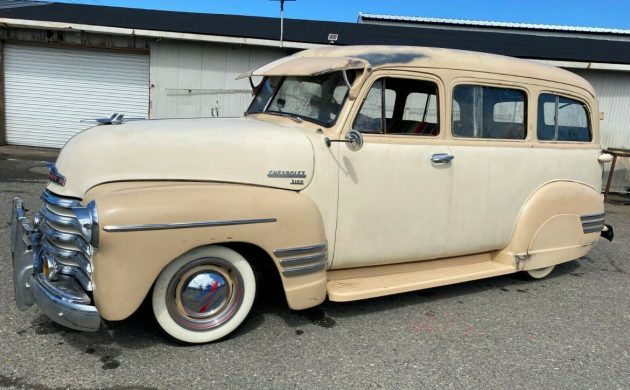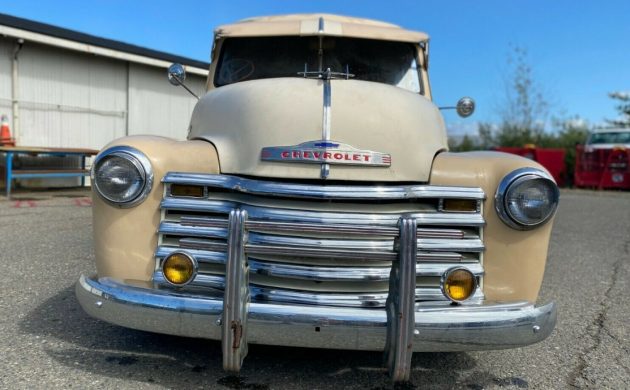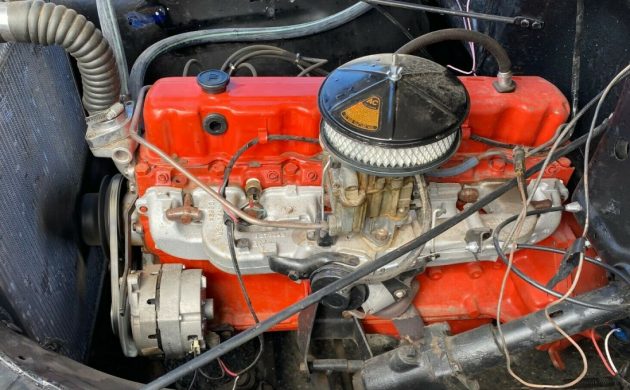While not exactly a flip, this 1953 Suburban was acquired two years ago on eBay and now it’s headed back that way. Whatever the case, here we have a third-generation Chevrolet Suburban being offered for sale. Somewhere in its past, it has undergone some notable mechanical modification and we’ll delve into that as we take a closer look. This truck is located in Tacoma, Washington and is available, here on eBay for a current bid of $11,100, reserve not yet met.
The Chevrolet Suburban is supposedly the longest continual domestic model name in use, having been introduced in 1935. By 1953, the Suburban was entering its final year of third-generation assembly, a model run that had started in 1947 and was based on Chevrolet’s then-new Advance-Design truck series. Compared to the current Suburban’s 134-inch wheelbase, this 1953 example, sitting on a 116-inch spread, could be considered a compact. First offered in the Suburban in ’53 was GM’s Hydramatic, four-speed automatic transmission but only the GMC version was fortunate enough to be the recipient. The Chevy variant would have to wait one more year.
And with that, a perfect segue into this Suburban’s powertrain, it is a 250 CI, in-line-six cylinder engine mated to a three-speed automatic transmission, all of the unknown provenance. We’re getting the old, “I don’t know nuffin’ about it” as the seller states, “I do not have a lot of info on this one”. Safe to say, he’s not the one that 86’d the original 216 CI, six-cylinder engine/three-speed manual transmission combination. He also doesn’t know how it runs or at least he’s not coughing up that information. Other than the air cleaner, the engine looks stock.
The body of this New Mexico truck has not been seen to have, or found to have, any rust according to the seller. And it’s in nice shape, the finish is flat, intentionally(?) and the rear doors/roof look like they are adorned with fake patina but the chrome, bumpers, and grille, are all strong. There is no overt evidence of corrosion or damage. Subjectively, the fender skirts ruin the Suburban’s existentialism but that’s my hang-up. The windshield sun-shade is a nice nod to the era; the wide white-walls? Not so much so but that’s a matter of taste too.
At first glimpse, it seemed as if the seller had gone with an Indian blanket front seat cover, but no, it looks like he went for the full Indian blanket upholstery treatment. It doesn’t look bad though the headliner and trim have all seen better days. The view from inside also indicates some pretty worn glass, though that may just b from lighting. The instrument panel is as it was intended though it appears to have been repainted, including some of the switches and knobs and the blue glove box lid doesn’t exactly match. The folding 2/3-1/3 rear seat is still in place, however, and that’s a nice touch besides the functional access that it provides to the way back. The seller advises,” All new Gauges, Steering wheel, all-glass all the way around, Door latches all rubber, window cranks all rubber and seals, channel windshield motor, Glove box ECT…” and I gather that he means all of these components come as parts that are included with the sale.
This Suburban is a nice start on a restoration; the mechanical changes are good but I could see going with more than what appears to be a stock 250 CI six. The exterior treatment is a matter of taste and the basics for the interior are either in place or in boxes, so that’s where the next effort needs to be expended. Any way that you consider this ’53 Suburban, it is a far cry from the 2020 edition and that’s not a bad thing at all. It is interesting to see what has been an important cog in the Suburban’s stellar 85-year success run, don’t you think?








Dear editors & writers at Bard Finds –
I will pay you one shiny nickel for every time you DON’T use the “p-word”, no matter how tempting it is…
Thank you,
Big_Fun
P.S. acceptable replacement words:
“Rustic”
“Shabby”
More to come…
Big_Fun:
A nickel, shiny or otherwise, ain’t gonna cut it. Blow the dust balls off the checkbook and let’s start talkin’ a deal.
JO
“Fake Patina” really? Is there a shortage of real patina that I was unaware of? Perhaps some “fake rust”, “fake mildew smell” and “fake oil leaks” would make this a real Winner.
What do you call it when the sun or age actually causes it, “real” patina? The “patina” on this Chevy looks “induced”, therefore fake.
JO
Considering a new one can cost 80,000 this may be a steal.
The ’39 taillights are a good idea. Did the same to a ’48 Crosley which had only one taillight. Started to build a street rod out of ’39 Chevy two door just because I thought the taillights were cool but a ’53 Studebaker coupe popped up that I couldn’t refuse and the Chevy went to diehard Chevy lover who would love this Suburban. Neat rig… agree on the skirts…wrong car for them.
Love the skirts on any car!
That “fancy pants” trim set is $2000 of the value alone…
Where would you even get fender skirts for something like this?
A good metal man could easily build those skirts. Takes some extra machinery to shape the outer edges and a big press to put the step across the bottom to match the fender… and skill. We do that kind of stuff but we’re more the couple two x fours and a big hammer types.
I don’t think I’ve seen all the chrome fender moldings on a Suburban before , those and all the extra chrome doo-dads on it are little too “hoopty” for my taste . At the very least I’d ditch the skirts, and get the ride height back either with the right size tires and/or the right springs
Did this once belonged to Liberace or Elvis? Not that there’s anything wrong with Liberace or Elvis, but to me it looks silly.
Thinking about the fake patina, those crazy Germans have spray on fake poo to make it look like you’ve been off road.
Creating “replica patina” of a type that is believable, requires a bit of research. We must remember what the “state of the art” was in 1953. With Chevrolet trucks, if it was a lighter color top coat as on this truck, the primer would have been red oxide prime, and the darker colors would have used cheaper black prime. [The black prime meant a much heavier top coat would be required for white or light tan, this was difficult to accomplish in production vehicles due to the risk of paint runs and sags.]
This situation is often the reason lighter colors were slightly more expensive on cars & trucks back then. I reference a 1948 Henney-Packard factory price guide that mentions an upcharge for white or other light colors because of the more expensive prime coat.
To create a believable patinated vehicle, one also needs to understand why the top coat is worn off certain locations, especially the tops of the front fenders [from working under the hood], the doors at the base of the windows [from bare human arms resting there], and other body locations where repeated polishing and using polishing compound along high points, ridges, and tight curved surfaces would often result in primer showing thru.
The primer spots showing thru on this vehicle, while nicely done, are not in the expected locations typically found on a vehicle like this.
like the Plymouth of the same name earlier yr (’49 – 55) better as it is smaller but not Duette (wolwo) @ ’53 – 69 (too small). By looks / by crook, all quite similar – hey, may B I could do w/a fleet – onea each (like Goldie Locks found sm, medium’n large)? Depending on the day/task? I am the “wagonman” after all (I claim that after 30, 40 yrs of em).